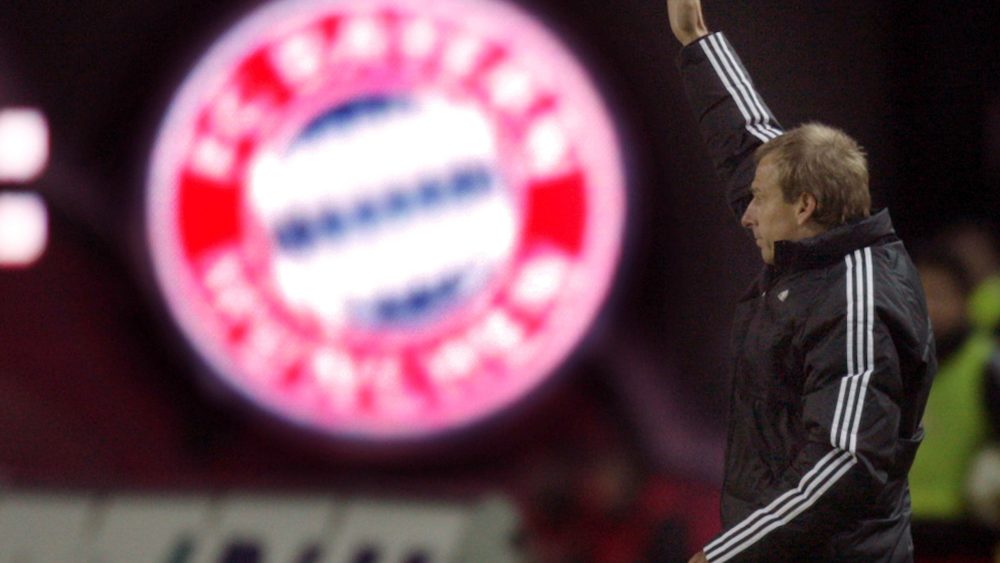Bundesliga MD 18 Preview: Hertha against Bayern
Hertha BCC – the Big City Club. This is the headline we gave to our first Bundesliga preview of the ongoing season. Back then, with a freshly closed investor deal in the bag and high hopes for coach Ante Čović, Hertha’s dreams were flying high.
Now, only half a year later, these dreams turn out to have been entirely too optimistic. The goal of joining the phalanx of Germany’s top teams have to be put on hold for the time being.
Čović had good ideas. But neither was he able to successfully convey them to his players nor was he given the time and the right environment he would have needed for his ideas to take roots. Now it is up to Jürgen Klinsmann to save the ship from sinking at least until the summer. Nobody in Berlin knows exactly what will happen after that. After all, Klinsmann was originally brought in for a position on the board. But suddenly, with him as coach, the team is producing results again.
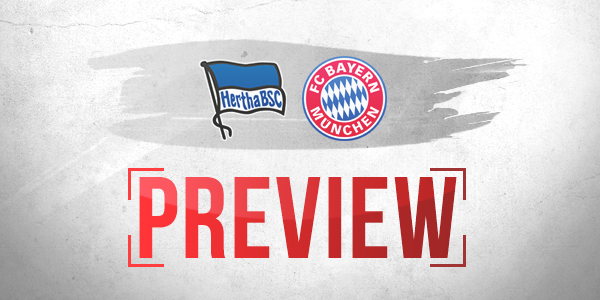
Hertha BSC: The perennial “plain Jane”?
After an opening defeat against Borussia Dortmund (1-2), there were two draws, one in Frankfurt (2-2) and one against Gladbach (0-0). In addition, the “Old Lady” also got victories in Leverkusen and at home against Freiburg (both 1-0). What is particularly striking is that after they conceded four goals in the first two games, Hertha did not concede a single one in the last three games.
Klinsmann and his newly installed team, consisting of Alexander Nouri, Markus Feldhoff, Werner Leuthardt and “performance manager” Arne Friedrich, have therefore already something to show for themselves. And yet, the excitement in the capital city does not run particularly high – at least among the fans and in the direct surrounding of the club.
Wherever Klinsmann has gone, he has brought about substantial change. Change is often accompanied with resistance and scepticism. In terms of transfers at least, not much has happened at Hertha so far. Salomon Kalou is allegedly allowed to look for a new club and Ondrej Duda and Eduard Löwen have already left Berlin. In terms of new signings, Santiago Ascacíbar has joined from Stuttgart for a fee of around €10M. Hertha were also interested in Granit Xhaka, but the deal fell through because of the recently changed coaching situation at Arsenal. So the first big deal to put all the newly acquired Windhorst millions to good use is yet to come.
New “benchmarking system”
Klinsmann’s most significant input so far has been methodological, an area where he collaborates closely with Manuel Friedrich. The influences from their time in the USA are clearly noticeable here. At the training camp in Florida, for example, Friedrich spoke about a new “benchmarking system” for the first team that the coaches want to introduce step by step.
Roughly speaking, the aim of this system is to establish performance indicators that monitor the state of each individual player in the personal as well as in the footballing, medical and athletic areas. The resulting values in each area are classified into three categories, which are represented by way of a classical three color traffic light.
With respect to the progress Klinsmann has brought to Hertha’s football so far, the traffic light should probably indicate yellow. The team has become much more stable defensively, which is not only evident in their few conceded goals, but also in their expected goals against. Under Čović, this value was 1.55 on average. Under Klinsmann, it has dropped to 1.36 in his five games, and even to 0.93 in the last three, clearly a significant progress.
The defense: Stable with minor problems
In the tactical area, Klinsmann and his team have taken a rather conservative approach without much innovation so far. After beginning with a back three in the first games, the coaches switched to a very tight 4-4-2 with almost all its variations against the ball: 4-5-1, 4-2-3-1, 4-3-3 (4-1-4-1). The focus in each case was to be as compact as possible in defense, while being able to break out and close down their opponents in midfield when the ball is there.
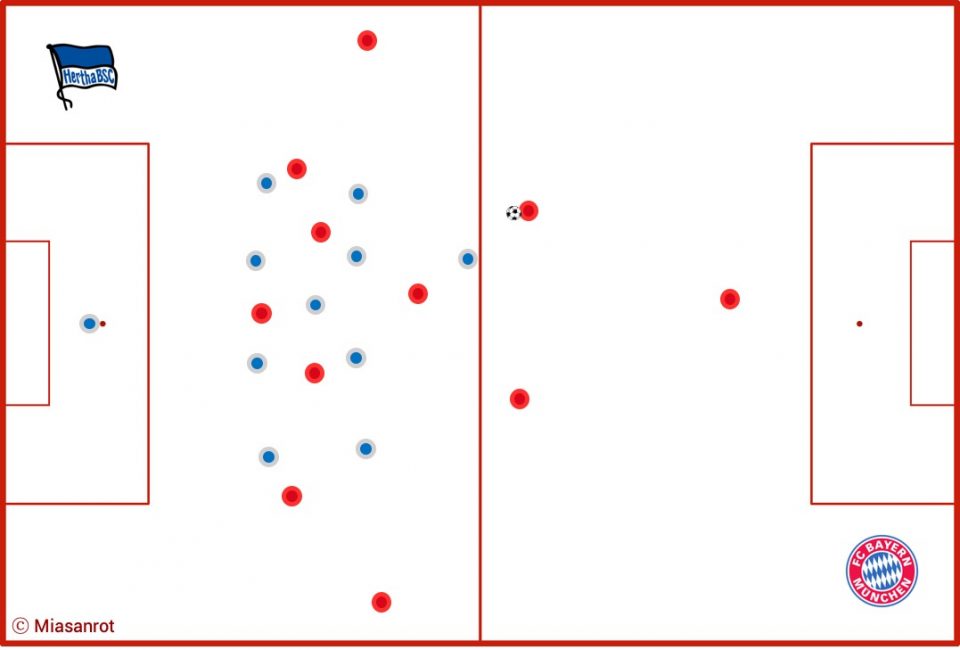
But that does not always succeed. At least one, sometimes even two, attackers often remain very high in Klinsmann’s system. If the two lines of four are then pinned back to their own penalty area by the opposing team, these players are missing in the center. Gladbach, for example, got some good chances as a result of this.
It was also noticeable that Hertha still has problems in finding the right horizontal compactness. Their wide players often shift inside to more tightly cover the center of the pitch. Especially against teams like Bayern, who always pose a threat from wide positions, the ground the defenders have to cover thus becomes too large. Perhaps Klinsmann will therefore make the switch back to a back three/five for the second half of the season. If not, it will be a matter of providing the back four with appropriate support from midfield.
One reason for Hertha’s hitherto problems could be their pronounced ball focus in defense. Players close to the ball sometimes move out of their positions too quickly, opening up spaces between the lines. A little more discipline in their positioning against the ball as well as a sense for the appropriate degree of compactness (vertical as well as horizontal) could help stabilize their defense even further.
Tactically intended limitation?
On the ball, Hertha relies almost exclusively on counterattacks. Klinsmann has repeatedly made it clear that he gives his players enormous latitude in decision making. For example, he has recently explained to German newspaper B.Z.: “Whether the players shoot or pass is a decision they make themselves anyway.” So far, this liberty has been quite evident on the pitch.
Hertha rarely has the ball. In the end, the only reason for their 48% possession against Dortmund was that Hummels was sent off with a red card shortly before the break, which caused Dortmund to fall back into a deeper position. Excluding the second half of this game, Hertha’s average share of possession for the rest of their games is around 35.5% with a peak of 40.5% against Gladbach and a low of 28.7% against Leverkusen.
In all five games under Klinsmann, Hertha had only 55 attempts on goal (i.e. 11 per game). Nevertheless, this was enough for about one expected goal per game. Fortunately for them, Hertha has players in attack who are very efficient at using their chances. This has been a main feature of their game in recent years. The team’s actual number of goals scored has almost always exceeded their xG value. This was the case in the first half of the ongoing season too, where Hertha’s 22 goals scored exceeded their xG value of 18.
Klinsmann seems to be aware of this quality and therefore deliberately focuses on strengthening his team’s defense. But Hertha has ambitious long-term plans. Friedrich wants “megalomania” and Klinsmann himself, despite the precarious table situation, has repeatedly mentioned the Champions League as a long-term goal. However, for his benchmarking indicator to change to green, a lot more needs to be done. In the long run, it would be too risky to always rely on the players’ efficiency in front of goal and on an above par decision making in critical situations. Hertha’s sometimes still very cumbersome and ill-conceived play in possession will not be enough to make the sort of huge strides Klinsmann envisages, their respectable initial successes notwithstanding.
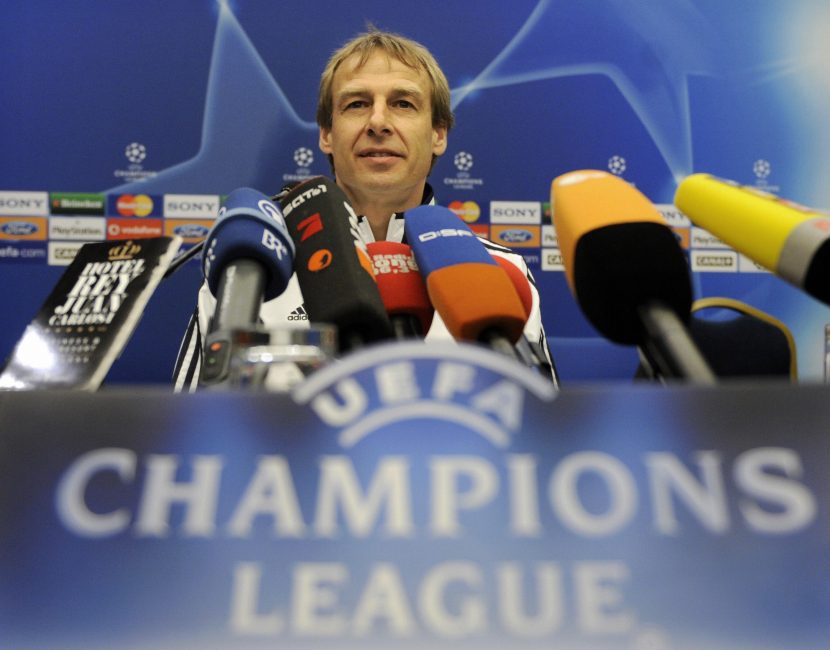
(Image: Lluis Gene/AFP via Getty Images)
The quality of the team and the progress in defense they have already made can propel Hertha back into a more reassuring midfield area in the standings. In the short run, this would even have to be considered a success. In the long run however, Hertha’s game has to improve on a broader front. Will Klinsmann bei able to finally implement the club’s hopes for a more offensive playing style that were associated with the appointment of Čović? Otherwise, the Big City Club will remain a plain Jane for quite some time to come.
FC Bayern: Getting down to the details
Hertha’s opponent on the weekend is an FC Bayern that still looks harried despite the break. Squad discussions here, injuries there – Bayern has not yet really got going. To make matters worse, they suffered a hefty 5-2 defeat against Nuremberg in a test match last weekend, which as a result should not be overstated because of a completely changed team for the second half. Nevertheless, the defeat brought some unrest to the team.
But there is a palpable, almost paradoxical contrast in the mood at Bayern at present. On the one hand, there is the sometimes harsh criticism of the transfer policy both from the outside and by Hansi Flick – albeit in a much milder form. On the other hand, however, FC Bayern oddly seems to be in a state of deep calm. The promising introduction of Oliver Kahn, a coach who is very satisfied with the players he has available, and a more self-assured sporting director than six months ago. Hasan Salihamidžić not only explained conclusively why Bayern made no move for Timo Werner last summer, but also why the winter transfer window is such a difficult market. The very relaxed figure he cuts in all of this suggests that Bayern may already have concrete transfer plans for the summer, which would explain their hesitant stance this winter – which would be a positive sign for FC Bayern overall.
And then there are the players who cannot stop raving about their new coach. Although they appear to be generally satisfied with where they are presently at, they send out robust signals as to their ambitions for the rest of the season. Hansi Flick and Joshua Kimmich, for example, have spoken of their great ambitions to challenge for the title in all three competitions.
Has the team done its homework?
The list of tasks is long. Setting aside the two knockout tournaments for a moment because of the difficult situation in the squad, winning the eight championship in a row alone is a challenging enough goal to reach already. Leipzig performed with extraordinary consistency in the first half of the season. Their squad is deep enough, the coach radiates a raw ambition that seems to have spilled over to the whole team, and they have played a very successful football so far.
There are no indications that a major slump at Leipzig is anywhere in sight. For Bayern this means that they will have to improve their own consistency if they are to catch up to the league leaders. Tactically, they need to work on their defensive stability against counter attacks on the break. Flick’s playing style based on a very high pressing and defending from the front undoubtedly brought about a revival of the record champions. But to keep their title hopes alive, they need to better defend the area in behind the last line of defense, especially in the wide spaces.
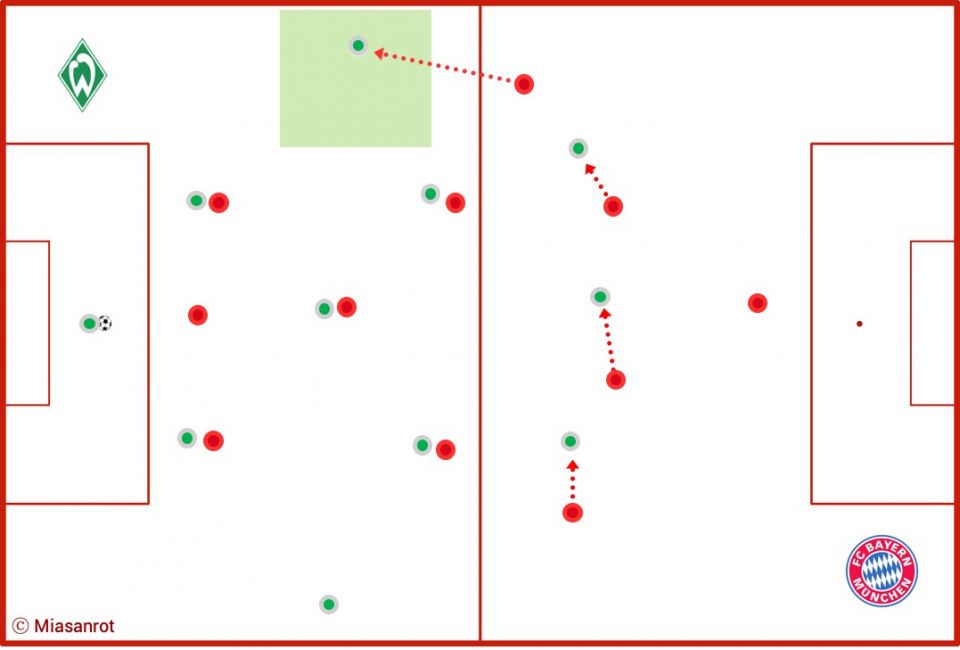
This graphic shows roughly how FC Bayern’s pressing mechanisms work. The idea is to isolate the opponent’s wide players and to put them under pressure then. So far this has usually worked quite well. But now it is a matter of increasing their consistency at doing this. When the full-backs push up high, they open up spaces behind them that the remaining three defenders have to close by shifting out. Whenever they failed to do this properly in the past, teams like Gladbach, Leverkusen or Freiburg too often managed to play the ball into the open area via the center, where Javi Martínez and Jérôme Boateng in particular did not have the pace to defend their opponents.
What color is Bayern’s performance?
There is a good chance that the speed deficiency in defense can be redressed with the return of Lucas Hernández or a newly signed right-back (with Pavard moving back to the center). On the other hand, these situations should not be reduced exclusively to a matter of speed. Bayern can counteract the emergence of large open spaces tactically without necessarily having to press later from a deeper position. This requires greater compactness, even better defined pressing triggers (i.e. situations that trigger the players’ runs to close down their opponents) and a more homogeneous overall setup.
Under Flick, Bayern managed to finish the year on a high. This trend needs to be continued now against Hertha, an opponent who likes to sit deep and break quickly. An opponent, therefore, who could specifically test Bayern in two aspects. First: How versatile is their attacking game? In past games, Bayern’s attack has too often depended on high crosses from the flanks. In the course of the second half of the season, this palette will have to broadend out. Against Hertha, crucial players Kimmich, Coman and Gnabry (who may be on the bench) will all be unavailable.
And second, how capable is the team of directing Hertha’s counter attacks out wide to minimize their threat? Considering his numerous unavailabilities, Flick is faced with the challenge to tweak his tactics to the highly probable start of Boateng in the center of defense. Too close on a note of the new Hertha vocabulary: The game on Sunday will be a first benchmark for the form of FC Bayern. Which color the traffic light will show, remains to be seen.

